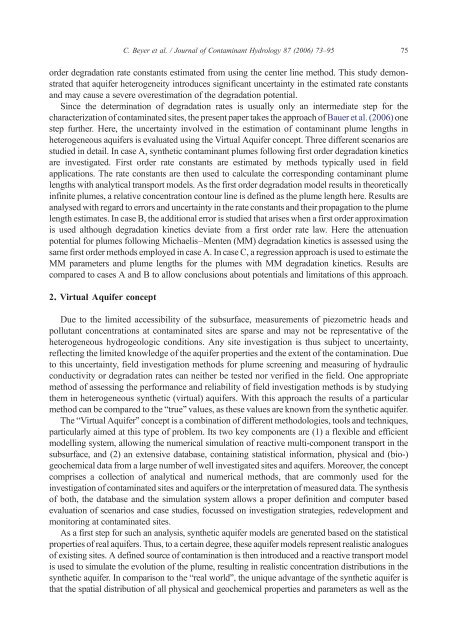Applied numerical modeling of saturated / unsaturated flow and ...
Applied numerical modeling of saturated / unsaturated flow and ...
Applied numerical modeling of saturated / unsaturated flow and ...
Create successful ePaper yourself
Turn your PDF publications into a flip-book with our unique Google optimized e-Paper software.
order degradation rate constants estimated from using the center line method. This study demonstrated<br />
that aquifer heterogeneity introduces significant uncertainty in the estimated rate constants<br />
<strong>and</strong> may cause a severe overestimation <strong>of</strong> the degradation potential.<br />
Since the determination <strong>of</strong> degradation rates is usually only an intermediate step for the<br />
characterization <strong>of</strong> contaminated sites, the present paper takes the approach <strong>of</strong> Bauer et al. (2006) one<br />
step further. Here, the uncertainty involved in the estimation <strong>of</strong> contaminant plume lengths in<br />
heterogeneous aquifers is evaluated using the Virtual Aquifer concept. Three different scenarios are<br />
studied in detail. In case A, synthetic contaminant plumes following first order degradation kinetics<br />
are investigated. First order rate constants are estimated by methods typically used in field<br />
applications. The rate constants are then used to calculate the corresponding contaminant plume<br />
lengths with analytical transport models. As the first order degradation model results in theoretically<br />
infinite plumes, a relative concentration contour line is defined as the plume length here. Results are<br />
analysed with regard to errors <strong>and</strong> uncertainty in the rate constants <strong>and</strong> their propagation to the plume<br />
length estimates. In case B, the additional error is studied that arises when a first order approximation<br />
is used although degradation kinetics deviate from a first order rate law. Here the attenuation<br />
potential for plumes following Michaelis–Menten (MM) degradation kinetics is assessed using the<br />
same first order methods employed in case A. In case C, a regression approach is used to estimate the<br />
MM parameters <strong>and</strong> plume lengths for the plumes with MM degradation kinetics. Results are<br />
compared to cases A <strong>and</strong> B to allow conclusions about potentials <strong>and</strong> limitations <strong>of</strong> this approach.<br />
2. Virtual Aquifer concept<br />
C. Beyer et al. / Journal <strong>of</strong> Contaminant Hydrology 87 (2006) 73–95<br />
Due to the limited accessibility <strong>of</strong> the subsurface, measurements <strong>of</strong> piezometric heads <strong>and</strong><br />
pollutant concentrations at contaminated sites are sparse <strong>and</strong> may not be representative <strong>of</strong> the<br />
heterogeneous hydrogeologic conditions. Any site investigation is thus subject to uncertainty,<br />
reflecting the limited knowledge <strong>of</strong> the aquifer properties <strong>and</strong> the extent <strong>of</strong> the contamination. Due<br />
to this uncertainty, field investigation methods for plume screening <strong>and</strong> measuring <strong>of</strong> hydraulic<br />
conductivity or degradation rates can neither be tested nor verified in the field. One appropriate<br />
method <strong>of</strong> assessing the performance <strong>and</strong> reliability <strong>of</strong> field investigation methods is by studying<br />
them in heterogeneous synthetic (virtual) aquifers. With this approach the results <strong>of</strong> a particular<br />
method can be compared to the “true” values, as these values are known from the synthetic aquifer.<br />
The “Virtual Aquifer” concept is a combination <strong>of</strong> different methodologies, tools <strong>and</strong> techniques,<br />
particularly aimed at this type <strong>of</strong> problem. Its two key components are (1) a flexible <strong>and</strong> efficient<br />
modelling system, allowing the <strong>numerical</strong> simulation <strong>of</strong> reactive multi-component transport in the<br />
subsurface, <strong>and</strong> (2) an extensive database, containing statistical information, physical <strong>and</strong> (bio-)<br />
geochemical data from a large number <strong>of</strong> well investigated sites <strong>and</strong> aquifers. Moreover, the concept<br />
comprises a collection <strong>of</strong> analytical <strong>and</strong> <strong>numerical</strong> methods, that are commonly used for the<br />
investigation <strong>of</strong> contaminated sites <strong>and</strong> aquifers or the interpretation <strong>of</strong> measured data. The synthesis<br />
<strong>of</strong> both, the database <strong>and</strong> the simulation system allows a proper definition <strong>and</strong> computer based<br />
evaluation <strong>of</strong> scenarios <strong>and</strong> case studies, focussed on investigation strategies, redevelopment <strong>and</strong><br />
monitoring at contaminated sites.<br />
As a first step for such an analysis, synthetic aquifer models are generated based on the statistical<br />
properties <strong>of</strong> real aquifers. Thus, to a certain degree, these aquifer models represent realistic analogues<br />
<strong>of</strong> existing sites. A defined source <strong>of</strong> contamination is then introduced <strong>and</strong> a reactive transport model<br />
is used to simulate the evolution <strong>of</strong> the plume, resulting in realistic concentration distributions in the<br />
synthetic aquifer. In comparison to the “real world”, the unique advantage <strong>of</strong> the synthetic aquifer is<br />
that the spatial distribution <strong>of</strong> all physical <strong>and</strong> geochemical properties <strong>and</strong> parameters as well as the<br />
75

















